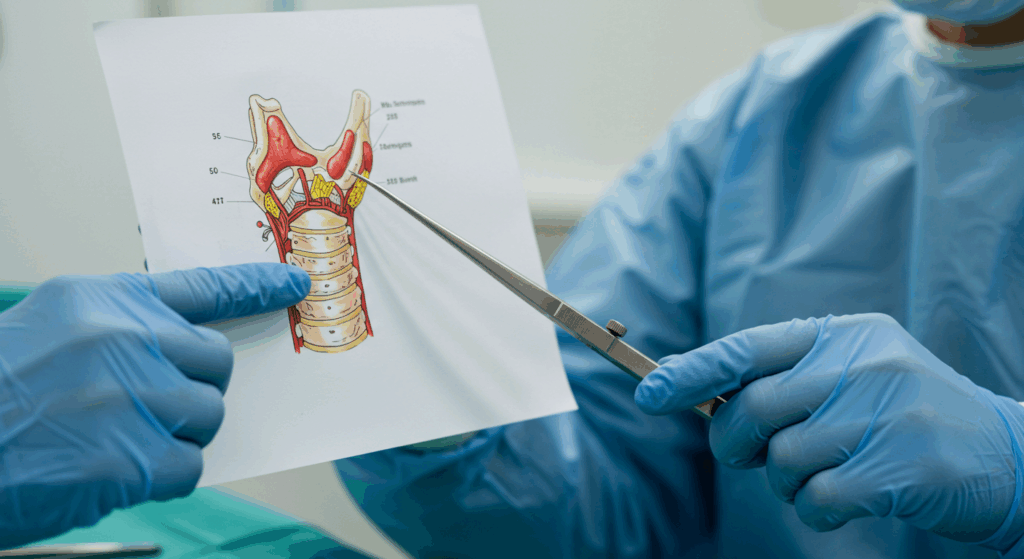For many transgender women and transfeminine individuals, the journey toward aligning their physical appearance with their true gender identity is a profound and deeply personal one. While many aspects of transition are celebrated, certain physical characteristics can remain a persistent source of discomfort and gender dysphoria. One of the most common of these is the Adam’s apple.
Its prominence is often seen as a distinctly “masculine” trait, a constant reminder of a past that doesn’t align with the present. Every glance in the mirror, every time you swallow, it can trigger feelings of incongruity. This is where Facial Feminization Surgery (FFS) plays a transformative role. Among the various FFS procedures, the Adam’s Apple Reduction, medically known as a Tracheal Shave or Chondrolaryngoplasty, stands out as one of the most powerful for achieving a softer, more feminine neck contour and alleviating significant dysphoria.
This comprehensive guide is written for you. It’s for the meticulous researcher who has spent countless nights scrolling through Reddit forums, the hopeful individual watching “FFS Journey” vlogs on YouTube, and the determined person ready to take the next step. We will delve deep into every aspect of the tracheal shave procedure, from the underlying anatomy to the recovery process and choosing the right surgeon. Our goal is to replace your anxiety with knowledge and your uncertainty with confidence.

1. The Anatomy of an Incongruence: Understanding the Adam’s Apple
Before we can discuss altering it, it’s crucial to understand what the Adam’s apple actually is and why it’s more prominent for some than for others.
- What is the Adam’s Apple?The “Adam’s apple” is the common term for the thyroid cartilage, which is the largest of the nine cartilages that make up the laryngeal skeleton, or “voice box” (larynx). Its primary function is to protect the vocal cords, which are located directly behind it. It’s not a bone, but a strong, flexible tissue.
- Why is it More Prominent in Individuals Assigned Male at Birth (AMAB)?During puberty, the influx of testosterone causes significant changes throughout the body, including the larynx. In AMAB individuals, the larynx grows larger and the front of the thyroid cartilage tilts forward, creating a more acute angle and a visible protrusion. This growth is also what causes the voice to deepen. In individuals assigned female at birth (AFAB), the larynx undergoes less growth during puberty, resulting in a wider, less prominent angle and a higher-pitched voice. The difference is purely anatomical, a secondary sex characteristic driven by hormones.
- The Deep Psychological Impact: More Than Just CartilageFor a transgender woman or transfeminine person, the Adam’s apple is far more than an anatomical feature. It is a symbol. It can be a primary source of gender dysphoria—the profound distress or discomfort that can occur when one’s physical characteristics do not align with their gender identity.This distress can manifest in numerous ways:
- Social Anxiety: A constant fear of being misgendered or “clocked” in public.
- Avoidance Behaviors: Wearing scarves or high-necked tops regardless of the weather to conceal the neck.
- Internal Disconnect: A feeling of alienation from one’s own reflection.
2. What is a Tracheal Shave? A Detailed Overview
A tracheal shave is a surgical procedure specifically designed to reduce the size of the thyroid cartilage to create a smoother, more feminine neck contour. The name “shave” is quite descriptive; the surgeon carefully shaves down the cartilage to make it less prominent, without compromising its protective function for the vocal cords.
- The Goal: Feminization, Not EliminationIt’s important to set realistic expectations. The goal of a tracheal shave is not to completely eliminate the thyroid cartilage—this would be impossible and dangerous. The objective is to reduce its anterior (front-facing) prominence so that it no longer creates a sharp, angular bump, resulting in a graceful and natural-looking neckline that aligns with feminine anatomy.
- Who Undergoes This Procedure?While most commonly associated with transgender women as part of FFS, tracheal shaves are also sometimes sought by cisgender men who feel their Adam’s apple is disproportionately large, or by non-binary individuals seeking a more androgynous appearance. The motivation, however, remains the same: to create a neck contour that feels more harmonious with one’s identity.
3. Are You an Ideal Candidate for Adam’s Apple Reduction?
Deciding to undergo surgery is a significant decision. A good surgeon will conduct a thorough evaluation to ensure you are a suitable candidate. This involves looking at both physical and psychological factors.
- Physical Criteria:
- Good General Health: You should be in good overall health to handle anesthesia and the healing process. Conditions like uncontrolled high blood pressure or bleeding disorders must be managed first.
- Anatomical Suitability: The surgeon will physically examine your neck, the prominence of your cartilage, and the thickness of your skin.
- Non-Smoker: Smoking severely impairs the body’s ability to heal and increases the risk of complications and poor scarring. You will be required to quit smoking for a significant period before and after surgery.
- Psychological and Emotional Criteria:
- Well-Understood Motivations: You should have a clear understanding of why you want the surgery and what you hope to achieve. The motivation should be for yourself and your own sense of well-being.
- Realistic Expectations: You understand the goals and the limitations of the procedure. You’ve reviewed before-and-after photos and know that the goal is natural-looking improvement, not a photoshopped ideal.
- Informed Consent: You have researched and understand the potential risks and complications, the recovery timeline, and the associated costs.
The journey often begins with a consultation, where you can discuss these points openly with a prospective surgeon.
4. The Surgical Procedure: A Step-by-Step Breakdown
Knowing exactly what will happen in the operating room can demystify the process and ease anxiety. Here is a detailed walk-through of a typical tracheal shave procedure.
- The Initial Consultation: This is your most important planning step. You will discuss your goals, the surgeon will assess your anatomy, and they will explain their proposed surgical plan. This is your time to ask every question you have.
- Pre-Operative Instructions: You’ll be given instructions to follow in the days or weeks leading up to surgery, which may include stopping certain medications (like aspirin or anti-inflammatories) and quitting smoking and alcohol.
- Anesthesia: A tracheal shave is typically performed under general anesthesia, meaning you will be completely asleep and comfortable throughout the procedure.
- The Incision: This is a key point of discussion during your consultation. The surgeon’s primary goal is to minimize visible scarring. There are two common approaches for the incision:
- Submental Incision (Under the Chin): A small incision is made in the crease directly under the chin. The surgeon then tunnels down to access the cartilage. The major advantage is that the scar is completely hidden from a direct frontal view.
- Direct Incision (In a Neck Crease): A small, horizontal incision is made directly over the Adam’s apple, carefully placed within a natural skin crease of the neck. When done skillfully, this scar can heal to be virtually invisible, resembling a natural line in the skin. The surgeon will recommend the best approach for your specific anatomy.
- The Reduction (“Shaving”): Once the thyroid cartilage is exposed, the surgeon uses a specialized surgical burr or scalpel. They will carefully and precisely shave down the excess cartilage, layer by layer. The most critical part of this step is protecting the vocal cords, which attach to the inside of the cartilage. An experienced FFS surgeon knows exactly how much can be safely removed without affecting the voice. They may use various techniques, such as an endoscope, to visualize the vocal cord attachment points from inside.
- Closing the Incision: After the desired reduction is achieved, the surgeon meticulously closes the incision using fine sutures. This careful closure is essential for minimizing the final scar.
- Duration: The procedure itself is relatively short, typically taking about 30 to 60 minutes.
5. Your Recovery Journey: Timeline, Tips, and What to Expect
Recovery from a tracheal shave is generally straightforward compared to more extensive FFS procedures, but it’s vital to follow post-operative instructions carefully.
- The First 24 Hours:You will wake up in a recovery area. You can expect some soreness in your throat, swelling, and bruising around the incision site. It might be uncomfortable to swallow. Your voice will likely be hoarse or weak—this is normal and temporary. Most patients can go home the same day.
- Week 1:
- Swelling and Bruising: This is the peak period for swelling and bruising.
- Pain Management: Pain is usually mild to moderate and can be managed with prescribed or over-the-counter pain medication.
- Voice Rest: It is crucial to rest your voice. Avoid talking as much as possible, and do not whisper, as it strains the vocal cords more than speaking softly.
- Activity: Light activity like walking is encouraged, but avoid anything strenuous.
- Suture Removal: Your sutures may be removed around the 7-day mark.
- Weeks 2-4:The swelling and bruising will significantly subside. Your voice will begin to return to normal, though some minor hoarseness may persist. You can typically return to a desk job and light daily activities.
- 1-3 Months:Most of the noticeable swelling will be gone, and you’ll begin to see the final contour of your neck. The incision line will still be pink or red but will start to fade.
- 6-12 Months:The healing process is now complete. The final result is visible, and the scar will have faded to its final appearance, which is often a very fine, pale line that is difficult to notice.
- Essential Recovery Tips:
- Sleep with your head elevated on a few pillows for the first week to help reduce swelling.
- Eat soft foods for the first few days to make swallowing more comfortable.
- Follow your surgeon’s scar care protocol. This may include using silicone sheets or gels to promote optimal healing.
- Protect the scar from the sun. Sun exposure can cause scars to darken permanently. Use a high-SPF sunscreen for at least a year.
6. Potential Risks and Complications
Every surgical procedure carries risks, and it is a sign of a trustworthy surgeon that they will discuss these with you openly. While the complication rate for a tracheal shave with an experienced surgeon is very low, potential risks include:
- Swelling and Bruising: Expected and temporary.
- Scarring: While minimized, a scar will always exist. In rare cases, individuals may develop keloid or hypertrophic scars.
- Temporary Hoarseness or Voice Weakness: Very common due to swelling around the larynx.
- Numbness: The skin around the incision may be temporarily numb.
- Infection: Rare, but possible with any surgery.
- Over- or Under-reduction: The surgeon may remove too little or, more seriously, too much cartilage.
- Permanent Voice Change: This is the most significant risk but is extremely rare in the hands of a qualified FFS specialist. It is the primary reason why choosing a surgeon with extensive experience in this specific procedure is non-negotiable.
7. The Most Important Decision: Choosing Your Surgeon
The success of your Adam’s apple reduction—both in its aesthetic outcome and its safety—depends almost entirely on the skill of your surgeon. For many, like our persona Elara, this means becoming a dedicated researcher. You might be looking locally or considering medical tourism to world-renowned FFS centers in places like Turkey, Spain, or Thailand.
Here’s what to look for and what to ask:
- Board Certification and Specialization: Your surgeon should be board-certified in a relevant field (like Plastic Surgery or Otolaryngology/ENT) and, most importantly, have a specialization in Facial Feminization Surgery. This is a sub-specialty that requires unique aesthetic judgment and technical skill.
- An Extensive Before-and-After Portfolio: Ask to see many examples of their work, specifically for tracheal shaves. Look for:
- Natural-looking results on a variety of patients.
- Well-healed, inconspicuous scars.
- Clear, high-quality photos from multiple angles.
- Patient Reviews and Testimonials: Look beyond the clinic’s website. Dig into the resources you already use:
- Reddit: Subreddits like
r/transgender_surgeriesare invaluable for unfiltered patient experiences and recommendations. - RealSelf: A platform where patients post reviews, photos, and cost information.
- Private Facebook Groups: These communities offer a safe space to ask for advice and see results.
- Reddit: Subreddits like
- Key Questions to Ask During Your Consultation:
- How many tracheal shaves have you performed?
- What is your preferred incision technique for my anatomy, and why?
- How do you specifically ensure the safety of the vocal cords during the procedure?
- What is your complication rate for this specific surgery?
- Can I speak with a former patient?
- What does your post-operative care plan look like, especially for international patients?
8. Navigating the Cost, Financing, and Insurance
FFS is a significant financial investment in your well-being.
- Typical Cost: The cost of a standalone tracheal shave can vary widely depending on the surgeon’s reputation and geographic location, but generally ranges from $4,000 to $8,000 USD. When combined with other FFS procedures, the cost may be lower than if performed alone.
- What’s Included?: Always get a detailed quote that specifies what is covered (surgeon’s fee, anesthesia fee, facility fee, post-op appointments, etc.).
- Insurance: In some countries and with some insurance plans, FFS procedures deemed medically necessary for treating gender dysphoria may be covered. This often requires extensive documentation, including letters from mental health professionals following WPATH (World Professional Association for Transgender Health) standards. The process can be challenging, but it is becoming more common.
- Financing: Many clinics offer financing plans or partner with medical credit companies to help patients manage the cost.
9. Combining Procedures for a Holistic Result
A tracheal shave is often performed as part of a more comprehensive FFS plan. Since you will already be under anesthesia, it is common to combine it with other procedures to harmonize the entire face. Common combinations include:
- Genioplasty (Chin Reshaping) and Jaw Contouring: To create a more tapered, less square lower face.
- Rhinoplasty (Nose Reshaping): To refine the size and shape of the nose.
- Forehead Contouring: To reduce the brow bone and create a smoother, more rounded forehead.
Combining procedures can be more cost-effective and involves a single recovery period.
10. Frequently Asked Questions (FAQ)
- Will my voice change permanently?When performed by an expert FFS surgeon, the risk of a noticeable, permanent negative change to your voice is extremely low. The goal is to only remove cartilage from the external, non-vibratory part of the structure. Temporary hoarseness is expected, but your normal pitch should return.
- How visible will the scar be?With proper surgical technique and post-operative care, the scar typically heals into a very fine line that is difficult to see. Its visibility depends on your skin type, the incision placement, and how well you care for it (especially sun protection).
- How much pain is involved?Pain is subjective, but most patients report it as mild to moderate. It is most acute in the first few days and is well-managed with medication. The feeling is often described as a sore throat.
- Can the cartilage grow back?No, the cartilage that is shaved away does not grow back. The results of a tracheal shave are permanent.

Conclusion: The Quiet Confidence of a Smooth Neckline
The journey of transition is about finding peace. It’s about closing the gap between who you know you are and what you see in the mirror. An Adam’s apple reduction is more than just a surgery; it’s a removal of a barrier. It’s an act of profound self-care that can quiet the persistent voice of dysphoria.
The final result isn’t about drama or radical change. It’s about subtlety. It’s the quiet confidence you feel when you can wear any neckline you choose. It’s the freedom of not having to hide. It’s the simple, beautiful peace of looking at your reflection and seeing a smooth, graceful neckline that finally feels like your own. This procedure can be a pivotal step toward living more freely, more confidently, and more authentically as yourself.
Visit Dr.MFO Instagram profile to see real patient transformations! Get a glimpse of the incredible results achieved through facial feminization surgery and other procedures. The profile showcases before-and-after photos that highlight Dr. MFO’s expertise and artistic vision in creating natural-looking, beautiful outcomes.
Ready to take the next step in your journey? Schedule a free consultation with Dr. MFO ( Best Facial Feminization Surgeon for You) today. During the consultation, you can discuss your goals, ask any questions you may have, and learn more about how Dr. MFO can help you achieve your desired look. Don’t hesitate to take advantage of this free opportunity to explore your options and see if Dr. MFO is the right fit for you.









